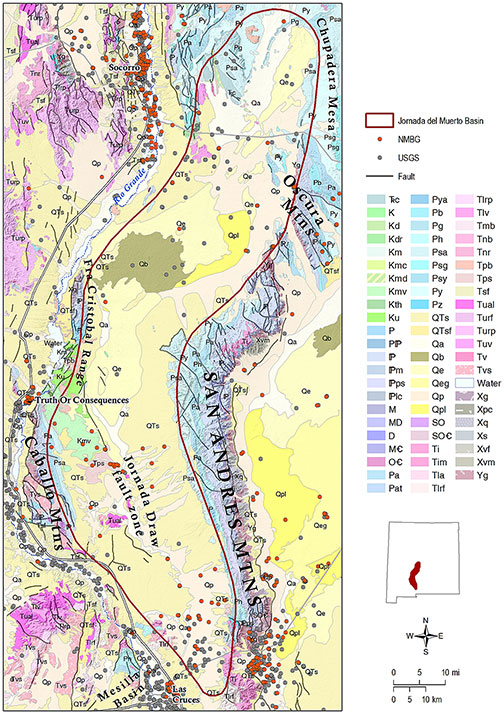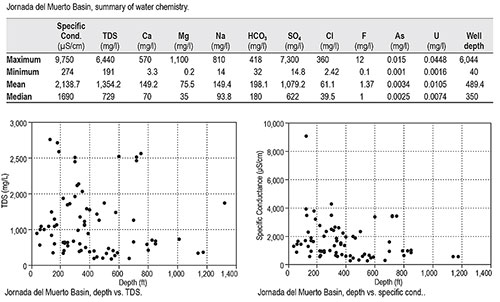
Overview of Fresh and Brackish Water Quality - Jornada del Muerto Basin


The Jornada del Muerto is a north-south trending basin lying to the east of the main Rio Grande Rift system in Socorro, Sierra, and Doña Ana Counties, New Mexico. The basin is ~160 miles long, averages 20 miles in width, and deepens to the south. The basin is bounded to the east by Chupadera Mesa and the Oscura and San Andres Mountains, and to the west by the Caballo and Fra Cristobal Mountains and the San Pasqual Platform. The south end of the Jornada del Muerto Basin merges imperceptibly with the northeast end of the Mesilla Basin. Unlike the Rio Grande Rift basins to the west, the Jornada del Muerto is a broad syncline that plunges to the south-southeast, formed between east-dipping Paleozoic and Mesozoic strata along the Caballo-Fra Cristobal Uplift and west-dipping Paleozoic strata in the San Andres Mountains. The basin is thus not part of the late Tertiary Rio Grande Rift extensional system, and Santa Fe Group basin-fill sediments are generally less than 350 feet thick (Chapin, 1971; Lozinsky, 1987; Roybal, 1991). The Jornada Draw fault zone runs from north to south and roughly parallels the hinge of the syncline. This fault zone significantly affects the groundwater system in the central part of the basin (Newton et al., 2015).
Principal water-bearing units in the Jornada del Muerto Basin are upper Cretaceous sandstones of the McRae and Gallup Formations, sandstones and conglomerates of the Eocene Love Ranch Formation, and Quaternary alluvium. Newton et al. (2015) identified two different hydrologic systems in the central part of the basin: a shallow perched system with depth to water generally <200 feet, and a deeper regional aquifer system with water depths >200 feet. The perched system is recharged by runoff of local precipitation that infiltrates through streambeds. The deeper aquifer system is recharged from downward movement of water from the shallow system, and from precipitation in the adjacent mountains that infiltrates into the subsurface and moves toward the center of the basin along deep flow paths. Regional movement of groundwater is to the south toward the Mesilla Basin.
TData coverage for the Jornada del Muerto is sparse (173 total data points), considering the large aerial extent of the basin, and irregularly distributed, with the majority of wells sampled concentrated at the south end of the basin near Las Cruces. Water quality is highly variable, and basin-wide mineral content is high, with mean TDS >1,300 mg/l. Plots of TDS and specific conductance vs. depth show significant scatter, indicating that those parameters do not vary with depth in a predictable manner. This phenomenon probably results from the presence of multiple bedrock aquifers and a shallow alluvial aquifer, as well as the presence of shallow and deep aquifer systems storing groundwater from at least two different sources (Newton et al., 2015).
Maximum well depth in the basin is 6,044 feet, in an exploratory well east of the Fra Cristobal range drilled by Sun Oil in 1955, for which very little water chemistry data is available. The deepest well for which a TDS record exists is 1,321 feet, with a dissolved solids content of 1,750 mg/l. This well is located northeast of Las Cruces at the far southern end of the basin, near the transition with the Mesilla Basin. Our limited records thus indicate that the potential for brackish water resources exists in the southern Jornada del Muerto Basin.
This project is funded by the New Mexico Environment Department, Drinking Water Bureau, under Source Water Protection.
For more information:
see: Overview of Regional Brackish Water Assessments
or contact:
Lewis Land — Hydrogeologist, lland@nckri.org
References
- Land, Lewis, 2016, Overview of Fresh and Brackish Water Quality in New Mexico - Jornada del Muerto Basin, Project Summary Sheet.
- Land, Lewis, 2016, Overview of Fresh and Brackish Water Quality in New Mexico, New Mexico Bureau of Geology Mineral Resources, Open-file Report, v. 0583, pp. 55.



